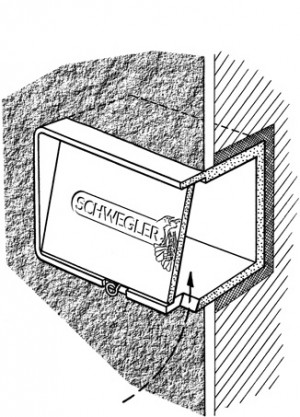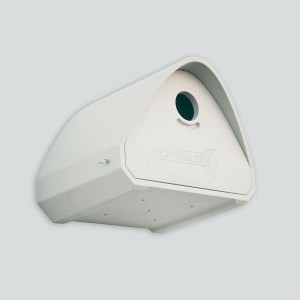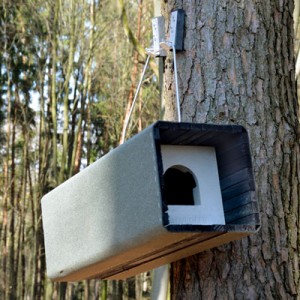General information on Swifts (Apus apus)
Swifts are uniquely adapted to life on the wing. They are mainly known and popular when a large number of them fly through our towns and cities on a warm summer evening, hunting for flying insects. During the summer months Swifts spend just four months in Europe, where they can be found all over the continent. They normally breed up to around 1,000 m above sea level. Winters are always spent south of the Sahara, for example, at the “Cape of Good Hope” in South Africa. Once they have been accepted, breeding sites are used by the same pair for many years, which means that removal of these roosts constitutes a serious threat to the Birds, as their familiar breeding site is missing on their return. Swifts are very social animals, so that colonies can form with any number of Birds. It is therefore advantageous if several nesting aids are installed. In principle a Swift pair occupies a nesting aid for one annual brood.
The survival of the Swift in our towns and cities is now under threat. This Bird species occupies niches and voices on all kinds of buildings. These places are often destroyed, blocked or at least made uninhabitable by building renovations or new buildings. SCHWEGLER replacement roosts can be used to create a very successful remedy. You can paint our nest boxes at any time with breathable paint to match the colour of the building façade. Please ensure that you only use paint that is “breathable”.
Swift Box No. 16
with entrance underneath
Swift nest boxes for installation in external walls of buildings or for adding to the external surface of the wall. If wall insulation is installed this box can also be inserted into the insulating layer (see Fig. 3). Its solid construction makes this type suitable for very exposed, sunny positions, free from any restrictions. The maximum depth to which it can be inserted is 17 cm, and this is determined by the position of the entrance hole on the underside. The box then projects by about 3 cm. If the box is to be installed flush with the external wall surface we recommend using the Type 16S (see below), which is more suitable because the entrance hole is at the front. The retaining strip (Order No. 00 614/1) must also be used when attaching with screws to the wall of a building or possibly when installing in a layer of insulation (see Fig. 3).
Material: SCHWEGLER wood-concrete.
Siting: On external façades or under the roofs of all kinds of buildings, for example, houses, industrial buildings, churches, road structures, walls or even cliffs and rock faces. For outdoor installation in very sunny locations. Alternatively, the boxes can also be bricked in or installed in the thermal insulation.
Installation: Can be installed within an external wall to a maximum depth of 17 cm in order to prevent the underneath entrance hole being blocked. It can also be attached to the surface of an external wall (or within a layer of rendering or external insulation) using the optional Fixing Bracket Order No. 00 614/1. The box can be painted, if desired, using standard air-permeable external wall paint. We recommend the use of our SCHWEGLER Nest Mould.
Cleaning and inspection: Cleaning is easy and convenient but not essential. By turning the safety catch, the front panel is easily removed.
Interior dimensions: W 36 cm x H 17 cm x D 16 cm.
External dimensions: W 43 cm x H 24 cm x D 22 cm (incl. fastener).
Weight: approx. 11 kg.
Includes: Nest box.
 English
English Deutsch
Deutsch 









